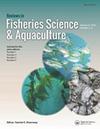A Review of “The History of Aquaculture”
引用次数: 0
Abstract
There is a wealth of information packed between the pages of this well-researched historical record of global aquaculture. To set the stage, Chapter 1 discusses the importance of fish and shellfish in the human diet. The middens of early man often contained bones and shells, supporting the conclusion that seafood was important for communities of hunters and gatherers. By the Bronze Age, preservation methods were being developed. In addition, some of the health benefits and dangers associated with consuming seafood (e.g., ciguatera and other toxins) began to be recognized. The next few chapters provide a chronicle of the development of aquaculture—often in its simplest, more extensive form. Typically, early aquaculture was nothing more than holding captured wild fish in captivity for a period of time, although carp aquaculture, including polyculture, was developed early in the period covered by Chapter 2, which focuses largely on Asia from 2000 BC to 500 AD One bit of information that I found interesting was that Marco Polo never mentioned fish in his detailed descriptions of the flora and fauna of China, not even in conjunction with the many rivers, streams, and other water bodies that he observed and remarked upon extensively. Chapter 3 describes subsistence farming during the Middle Ages from 500 to 1450 AD. Included is a description of the importance of fish in monastic life in Europe, the rise of feudalism during which time landowners owned the fish and poaching by peasants was a capital offense, and how the Magna Carta of 1215 began to change the system. Development of the tambaks of southeast Asia, the construction and maintenance of fish ponds by Pacific islanders, and the floodplain farms in South America are described. Nash next describes the dawn of science for the period from 1460 to 1900 AD (Chapter 4). Aquaculture activities during that and other periods were often impacted by political decisions that led to both active development as well as declines in production. During the 19th century, steam and later internal combustion engines powered commercial fishing vessels and opened up vast areas for commercial fishing. The industrial revolution also led to pollution of coastal waters and rivers and depletion of the associated fish stocks, particularly in Europe. Inland fisheries and aquaculture in Europe declined as pond areas were drained to provide additional space for agriculture. Yet, as discussed in Chapter 5, it was during the period from 1750 to 1880 AD that the seeds were sown from which modern aquaculture grew. Harvested in Asia for millennia, seaweed culture probably began in the 18th century in Japan and later spread to China. In Europe, techniques for spawning and hatching trout were published in the later part of the century, followed in the 19th century by a variety of aquatic animals, including salmon, eels, oysters, and various freshwater species. The first European fish hatchery was established in France in 1852. Fish produced in the hatchery were stocked in French rivers and also distributed to interested fish culturists in England and other European nations. Hatcheries sprang up across the continent. Rainbow trout for the United States were shipped to Europe beginning in 1879 and were used to stock streams to support recreational fisheries. In North America, trout were first spawned in the state of Ohio in 1853. Trout and salmon hatcheries were developed in both the United States and Canada, primarily for producing fish to support recreational fisheries. In 1871, the U.S. Fish and Fisheries Commission was created. The person behind establishment of the commission and its first director, Spencer F. Baird, was dedicated to stocking a wide variety of fish species across the nation to enhance both sport and commercial fisheries in fresh and marine waters. Ultimately, hundreds of billions of eggs, fry, and/or fingerlings were stocked over a period of several decades (see Stickney, 1996a,b,c,d,e, 1997a,b,c, 1998, 1999). Mariculture from 1880 to 1920 is the subject treated in Chapter 6. When the idea was put forward to produce fish in hatcheries to stock the oceans, there was considerable opposition to it—not from any of the fears being expressed by various groups today, but from those who believed that it was a waste of time because the natural fish populations were inexhaustible. However, the International Fish Exhibition in 1883 showed off much of the technology that had been developed for hatching marine fishes, and attendees from several countries went home to try their hand in using the techniques they had seen. The period saw the appearance of the first commercial fish hatcheries, along with《水产养殖史》述评
在这本经过充分研究的全球水产养殖历史记录中,有丰富的信息。作为铺垫,第一章讨论了鱼类和贝类在人类饮食中的重要性。早期人类的脊骨通常含有骨头和贝壳,这支持了海鲜对猎人和采集者社区很重要的结论。到了青铜器时代,保存方法开始发展。此外,人们开始认识到与食用海产品有关的一些健康益处和危险(例如雪卡水和其他毒素)。接下来的几章提供了水产养殖发展的编年史-通常是最简单,更广泛的形式。通常,早期的水产养殖只不过是将捕获的野生鱼类圈养一段时间,尽管鲤鱼养殖,包括混养,在第二章所涵盖的时期就已经发展起来了,主要集中在公元前2000年到公元500年的亚洲。我发现有趣的一点信息是,马可波罗在他对中国动植物的详细描述中从未提到过鱼,甚至没有将许多河流,小溪,以及他广泛观察和评论的其他水体。第三章描述了中世纪(公元500年至1450年)的自给农业。书中描述了鱼在欧洲修道生活中的重要性,封建主义的兴起,在此期间,土地所有者拥有鱼,农民偷猎是一种死罪,以及1215年《大宪章》如何开始改变这一制度。描述了东南亚的tambaks的发展,太平洋岛民对鱼塘的建设和维护,以及南美洲的洪泛平原农场。纳什接下来描述了公元1460年至1900年这一时期的科学曙光(第4章)。在这一时期和其他时期,水产养殖活动经常受到政治决策的影响,这些决策既导致了积极的发展,也导致了产量的下降。在19世纪,蒸汽和后来的内燃机为商业渔船提供动力,为商业捕鱼开辟了广阔的地区。工业革命还导致了沿海水域和河流的污染以及相关鱼类资源的枯竭,特别是在欧洲。欧洲的内陆渔业和水产养殖业下降,因为池塘区域被抽干,以提供额外的农业空间。然而,正如第五章所讨论的,正是在公元1750年至1880年期间,播下了现代水产养殖的种子。海藻在亚洲已经收获了几千年,海藻养殖可能始于18世纪的日本,后来传播到中国。在欧洲,鳟鱼的产卵和孵化技术在19世纪后期出版,随后在19世纪出版了各种水生动物,包括鲑鱼、鳗鱼、牡蛎和各种淡水物种。欧洲第一个鱼类孵化场于1852年在法国建立。孵化场生产的鱼被储存在法国的河流中,也分发给英国和其他欧洲国家感兴趣的养鱼者。孵化场如雨后春笋般遍布整个大陆。从1879年开始,美国的虹鳟鱼被运往欧洲,用于储存溪流,以支持休闲渔业。在北美,鳟鱼最早于1853年在俄亥俄州产卵。美国和加拿大都开发了鳟鱼和鲑鱼孵化场,主要用于生产鱼类以支持休闲渔业。1871年,美国渔业委员会成立。该委员会的创始人和首任主任斯宾塞·f·贝尔德(Spencer F. Baird)致力于在全国范围内饲养各种鱼类,以促进淡水和海洋水域的运动和商业渔业。最终,在几十年的时间里,储存了数千亿的鱼卵、鱼苗和/或鱼种(见Stickney, 1996a,b,c,d,e, 1997a,b,c, 1998, 1999)。从1880年到1920年的海水养殖是第六章所讨论的主题。当人们提出在孵化场生产鱼类以补充海洋资源的想法时,遭到了相当大的反对——不是来自今天各种团体所表达的任何恐惧,而是来自那些认为这是浪费时间的人,因为自然的鱼类种群是取之不尽的。然而,1883年的国际鱼类展览会展示了许多已经开发出来的孵化海鱼的技术,来自几个国家的与会者回家尝试使用他们所看到的技术。这一时期出现了第一批商业鱼类孵化场
本文章由计算机程序翻译,如有差异,请以英文原文为准。
求助全文
约1分钟内获得全文
求助全文

 求助内容:
求助内容: 应助结果提醒方式:
应助结果提醒方式:


